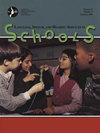形态意识:连接语言基础和学术素养的学生与语言和读写能力的缺陷。
IF 2.9
3区 医学
Q1 AUDIOLOGY & SPEECH-LANGUAGE PATHOLOGY
Language Speech and Hearing Services in Schools
Pub Date : 2025-06-18
DOI:10.1044/2025_lshss-24-00119
引用次数: 0
摘要
目的:对于有语言和读写能力缺陷(LLD)的学龄学生,比如那些有发展性语言障碍(DLD)和/或阅读障碍的学生,读写能力的挑战会影响阅读理解、书面语言和整体学业成绩。研究人员已经确定,形态学意识的教学,特别是语音、正字法、语义和句法的教学,会产生积极的阅读和写作效果。这篇临床重点文章的目的是为基于形态学意识的多语言读写干预方法提供证据,以及在相关学术背景下实施的基于案例的教程。方法关注词内的形态意义成分提供了一个理想的机会,可以反思这些单位如何为其他相关的语言成分(如音韵或单词发音、正字法拼写、语义和句法语法)提供线索和支持。讨论了在多语言读写干预方法中利用词形意识来连接基础语言知识和桥梁策略、意义和目的。我们讨论了如何将这种干预与课堂课程单元相结合,并通过个人、小组或基于课堂的干预来实施。结论语素意识干预对低语速障碍学生的词汇、解码、拼写和阅读理解有促进作用。因此,将这种元语言策略融入到整合学术相关文本的多语言读写干预中,可以成为语言病理学家和读写专家支持DLD和/或阅读障碍学生成功读写的有力工具。本文章由计算机程序翻译,如有差异,请以英文原文为准。
Morphological Awareness: Connecting Language Foundations and Academic Literacy Success for Students With Language and Literacy Deficits.
PURPOSE
For school-age students with language and literacy deficits (LLD), such as those with developmental language disorder (DLD) and/or dyslexia, literacy challenges can affect reading comprehension, written language, and overall academic success. Researchers have established that instruction in morphological awareness, especially with a phonological, orthographic, semantic, and syntactic focus, results in positive reading and writing outcomes. The purpose of this clinical focus article is to provide evidence for a multilinguistic literacy intervention approach grounded in morphological awareness, along with a case-based tutorial for its implementation in a relevant academic context.
METHOD
Focusing on the morphological meaning components within words provides an ideal opportunity to reflect on how these units provide clues and support to other linked language components such as phonology or word pronunciation, orthographic spelling, semantic meaning, and syntactic grammar. A discussion is provided for leveraging morphological awareness across a multilinguistic literacy intervention approach to connect foundational linguistic knowledge and bridge strategy, meaning, and purpose. We address how this intervention can be integrated with a classroom curricular unit and implemented via individual, small-group, or classroom-based intervention using a case-based example.
CONCLUSIONS
Morphological awareness intervention has been found to be effective in supporting the vocabulary, decoding, spelling, and reading comprehension of students with LLD. Thus, infusing this metalinguistic strategy in multilinguistic literacy intervention that integrates academically relevant texts can be a powerful tool for speech-language pathologists and literacy specialists to support the literacy success of students with DLD and/or dyslexia.
求助全文
通过发布文献求助,成功后即可免费获取论文全文。
去求助
来源期刊

Language Speech and Hearing Services in Schools
Social Sciences-Linguistics and Language
CiteScore
4.40
自引率
12.50%
发文量
165
期刊介绍:
Mission: LSHSS publishes peer-reviewed research and other scholarly articles pertaining to the practice of audiology and speech-language pathology in the schools, focusing on children and adolescents. The journal is an international outlet for clinical research and is designed to promote development and analysis of approaches concerning the delivery of services to the school-aged population. LSHSS seeks to advance evidence-based practice by disseminating the results of new studies as well as providing a forum for critical reviews and meta-analyses of previously published work.
Scope: The broad field of audiology and speech-language pathology as practiced in schools, including aural rehabilitation; augmentative and alternative communication; childhood apraxia of speech; classroom acoustics; cognitive impairment; craniofacial disorders; fluency disorders; hearing-assistive technology; language disorders; literacy disorders including reading, writing, and spelling; motor speech disorders; speech sound disorders; swallowing, dysphagia, and feeding disorders; voice disorders.
 求助内容:
求助内容: 应助结果提醒方式:
应助结果提醒方式:


